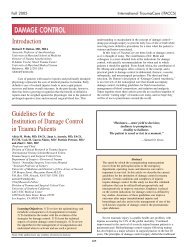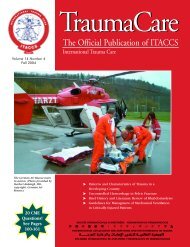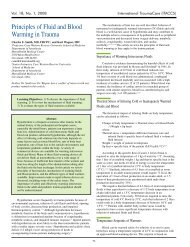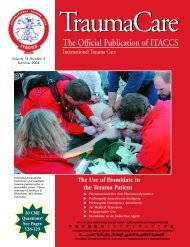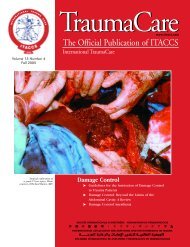The Official Publication of ITACCS - International Trauma ...
The Official Publication of ITACCS - International Trauma ...
The Official Publication of ITACCS - International Trauma ...
You also want an ePaper? Increase the reach of your titles
YUMPU automatically turns print PDFs into web optimized ePapers that Google loves.
<strong>ITACCS</strong> Spring 2003<br />
IVF resuscitation in certain uncontrolled hemorrhage models and one major clinical study<br />
has even shown the efficacy <strong>of</strong> withholding IVF infusions preoperatively in those patients<br />
with penetrating torso injuries (versus the standard rapid infusions <strong>of</strong> IVF in both the prehospital<br />
and emergency department settings). It is therefore speculated that BP elevation,<br />
prior to achievement <strong>of</strong> hemostasis, may actually increase mortality in certain subgroups <strong>of</strong><br />
injury patients. <strong>The</strong> rationale, experimental evidence, scientific design, and limitations <strong>of</strong><br />
these studies will be examined and qualified in this discussion. In addition, the concept <strong>of</strong><br />
using hypertonic solutions and new hemoglobin-based oxygen carriers in such circumstances<br />
will be analyzed as well.<br />
Bibliography<br />
Bickell W, Wall M, Pepe P, et al. Immediate versus delayed fluid resuscitation for<br />
hypotensive patients with penetrating torso injuries. Resuscitation 1995;<br />
29(2):183–4.<br />
Dutton R, Mackenzie C, Scalea T. Hypotensive resuscitation during active hemorrhage:<br />
impact on in-hospital mortality. J <strong>Trauma</strong> 2002; 52:1141–6.<br />
Fowler RL, Pepe PE. Prehospital care <strong>of</strong> the patient with major trauma. Emerg Med Clin<br />
North Am 2002; 20:953–74.<br />
Manning JE, Katz LM, Brownstein MR, et al Bovine hemoglobin-based oxygen carrier<br />
(HVOC-291) for resuscitation <strong>of</strong> uncontrolled, exsanguinating liver injury in swine.<br />
Shock 2000; 13:152–9.<br />
Pepe PE, Lurie K, Raedler C. Emergency ventilatory management in hemorrhagic<br />
states: elemental or detrimental? J <strong>Trauma</strong> June 2003; 54(6), in press.<br />
Pepe PE, Mosseso V, Falk JL. Prehospital fluid resuscitation <strong>of</strong> the patient with major<br />
trauma. Prehosp Emerg Care 2002; 6(1):81–91.<br />
Stern SA. Low-volume fluid resuscitation for presumed hemorrhagic shock: helpful or<br />
harmful. Curr Opin Crit Care 2001; 7:422–30.<br />
Stern SA, Wang X, Mertz M, et al. Effect <strong>of</strong> initially limited resuscitation in a combined<br />
model <strong>of</strong> fluid percussion brain injury and severe uncontrolled hemorrhagic shock.<br />
J Neurosurg 2000; 93:305–14.<br />
Stern SA, Zink BJ, Mertz M, et al. Under resuscitation <strong>of</strong> near-lethal uncontrolled hemorrhage:<br />
effects on mortality and end-organ function at 72 hours. Shock 2001;<br />
15:16–23.<br />
Prehospital Use <strong>of</strong> Hypertonic Saline Derivatives<br />
Pr<strong>of</strong>essor Pierre Carli, MD, PhD<br />
Department <strong>of</strong> Anesthesiology, Hôpital Necker–Enfants Malades, Paris, France<br />
Learning Objectives: 1) To understand the importance <strong>of</strong> correct assessment <strong>of</strong> the<br />
status <strong>of</strong> trauma cases in the prehospital setting and 2) to learn the use <strong>of</strong> small-volume<br />
hypertonic solutions in penetrating trauma for rapid fluid replacement, providing a modified<br />
systemic arterial pressure capable <strong>of</strong> maintaining vital functions while limiting the<br />
possibility <strong>of</strong> further hemorrhage.<br />
Hypertonic saline solutions associated with colloids are particularly suitable for prehospital<br />
use in major trauma.<br />
In European EMS systems, where physicians are involved in prehospital care, three<br />
steps <strong>of</strong> management are closely linked. First, the on-site evaluation <strong>of</strong> the patient is essential<br />
to assess the mechanism <strong>of</strong> the injuries and the respiratory and ventilatory status. Special<br />
care must be taken with penetrating trauma with hypotension or multiple blunt trauma with<br />
severe brain injury because the management <strong>of</strong> these patients is different.<br />
Second, on-site respiratory management in order to provide efficient airway ventilation<br />
and oxygenation is the first priority <strong>of</strong> treatment. Stabilisation <strong>of</strong> respiratory status improves<br />
patient survival. Prehospital intubation is indicated in severe trauma patients who are unconscious<br />
(GCS






